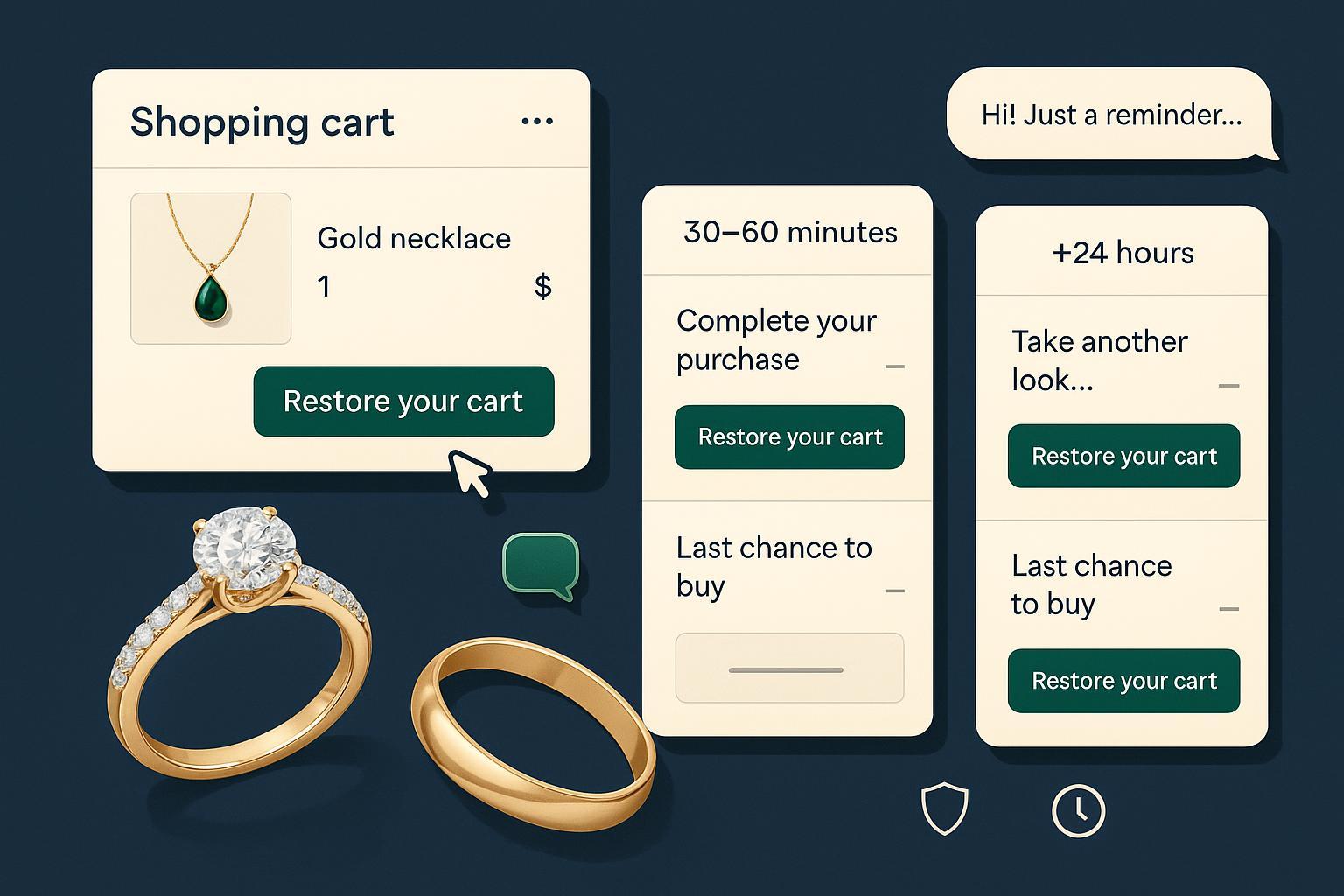How To Create High-Converting Abandoned Cart Emails for Jewelry Products

Design and launch a three-touch abandoned cart email flow (with an optional SMS nudge) tailored to jewelry. You’ll ship a brand-safe program that recovers revenue without eroding margins or luxury positioning. Expect, conservatively, opens around 40–50% and conversions from send in the 3–6% range when executed well, based on 2024–2025 benchmarks reported by platforms like Klaviyo’s abandoned cart benchmarks and category roundups such as Shopify’s 2025 guide and examples.
Time required: 3–5 hours to stand up v1; 1–2 weeks for testing/optimization Difficulty: Intermediate (ESP + Shopify familiarity recommended) You’ll need: Your ESP (e.g., Klaviyo, Omnisend, etc.), product catalog, brand assets, and cart-restore links
Step 1 — Set goals and guardrails
Define success and protect your brand equity before building.
-
Set KPIs and target ranges
- Open rate: 40–50%; top performers can exceed 55–65% per 2024–2025 data from Klaviyo’s benchmarks.
- Click rate: 6–12% (top ~13%). CTR varies by study; some 2024 datasets like Hotjar’s cart abandonment stats report higher CTR ranges due to methodology.
- Conversion (from send): 3–6% typical; recovery gains improve with fast first send and strong assurance content as noted in Shopify’s 2025 overview.
-
Define brand guardrails
- Start with non-discount value; reserve discounts for targeted segments. See the value-first approach advocated in Emarsys best practices (2025).
- Protect VIPs from broad discounts; cap total messages to 3 per event.
-
Compliance baseline
- Capture consent (email and SMS separately), honor opt-outs, and document your policy.
Checkpoint
- Write down targets and rules now; you’ll use them to decide offers and limits later.
Step 2 — Map the jewelry-specific sequence and timing
Use a concise three-email cadence that respects luxury consideration cycles.
- Email 1 (T+30–60 minutes): Reminder + restore-cart CTA
- Purpose: Capture fresh intent; stay clean and reassuring.
- Email 2 (T+24 hours): Objection handling + social proof
- Purpose: Address sizing, authenticity, warranty, shipping, financing, and returns.
- Email 3 (T+72 hours): Value-add or controlled incentive
- Purpose: Provide a tasteful nudge—non-discount perk or modest, time-bound offer.
This three-touch structure reflects broadly recommended timings from lifecycle leaders including Shopify’s 2025 guide and Omnisend’s best practices (2025). For higher-ticket pieces, consider a final “concierge” follow-up 5–7 days later, but only if complaint rates and unsubscribes are stable.
Checkpoint
- In your ESP, create a flow with these delays. Add a purchase suppression rule so messages stop when the buyer converts.
Step 3 — Craft jewelry-first creative and copy
Focus on clarity, assurance, and luxury detail.
-
Subject lines and preview text
- Prioritize clarity over clickbait; reference the item and value. For guidance on clarity and personalization tactics, see Bloomreach’s 2024 strategies.
- Examples: “Still considering the 14k Oval Solitaire? Your cart is saved.” | “Sizing, warranty, and delivery details for your bracelet.”
-
Visual standards
- Use macro photography, 360/short video, and scale cues. Show on-model across diverse skin tones; include carat/metal details.
-
Assurance and friction removal
- Size/fit support: link to ring/bracelet sizing guides and highlight free resizing or easy exchanges.
- Authenticity and quality: note certifications (e.g., GIA reports when applicable), hallmarking, and craftsmanship.
- Care, warranty, and shipping: emphasize insured shipping, delivery timelines, and repair coverage.
-
Social proof
- Include relevant reviews/UGC; avoid generic testimonials—reference the product or collection.
Why it matters
- Jewelry abandonment often stems from uncertainty (size, authenticity, returns). Addressing these directly improves conversion without defaulting to discounts.
Step 4 — Incentives that protect margins (value-first)
Lead with value-adds before discounts. This preserves brand equity and AOV.
-
Value-first menu
- Complimentary first resize or polishing/care kit
- Free gift wrap or shipping upgrade
- Extended holiday returns or satisfaction guarantee
-
Discount rules (if necessary)
- Introduce only at Email 3; make it modest and time-bound; use single-use codes; suppress when sitewide promos exist.
- Segment: offer discounts to price-sensitive or multi-abandoner cohorts; keep VIPs on value-adds. This mirrors guidance in Emarsys (2025) and approaches featured in Shopify’s 2025 examples.
Checkpoint
- Decide and document the exact perk or offer thresholds by segment to avoid ad hoc decisions later.
Step 5 — Pair with SMS (consent-first and light-touch)
Use one SMS nudge per event when you have explicit consent. Keep it brief and respectful.
-
Timing
- Send within 60–90 minutes of abandonment or coordinate with Email 1; never duplicate copy.
-
Content
- Identify your brand, include a short reassurance hook (e.g., sizing help or delivery ETA), a cart-restore link, and an easy opt-out (e.g., “Reply STOP”).
-
Compliance
- In the U.S., marketing texts require prior express written consent per the FCC’s TCPA rules; enforcement details and opt-out handling updates were clarified in 2024 (effective 2025) in the FCC Federal Register rulemaking.
- Follow the CTIA Messaging Principles for clear consent language, brand identification, and honoring STOP keywords; observe reasonable quiet hours.
- In the UK/EU, ensure valid opt-in under PECR/GDPR with clear opt-out per the UK ICO direct marketing guidance.
Checkpoint
- Verify SMS consent collection and quiet-hour settings before enabling the nudge.
Step 6 — Deliverability and technical checklist (do this once, then monitor)
- Authenticate your sending domain with SPF, DKIM, and DMARC; enable one‑click unsubscribe. Gmail/Yahoo and Outlook tightened requirements in 2024–2025—meet them to avoid spam placement.
- Keep total HTML under ~102KB; compress images (<100KB each where possible) and include descriptive alt text.
- Use branded, HTTPS tracking links (e.g., links.yourbrand.com) and verify UTMs.
- Test the cart-restore deep link on mobile and desktop; ensure it repopulates the abandoned items.
- Include a plain‑text version and balance text-to-image ratio (~60:40) for better inboxing.
Checkpoint
- Send test emails to major inboxes, validate link integrity, and confirm load speed on 4G.
Step 7 — Segment and personalize like a jeweler
Go beyond “all abandoners.” Segment by intent and value.
- VIPs: High AOV, loyal buyers → value-add perks, concierge tone, no discounts.
- Browsers/first-timers: Emphasize assurance (sizing, returns, authenticity) and social proof.
- Gift buyers: Occasion-focused copy (anniversaries, birthdays), gift wrap, delivery-by dates.
- Price-sensitive/multi-abandoners: Consider modest, single-use discounts only at the final touch.
- Product cues: Suggest alternative metals/sizes/finishes and tasteful cross-sells (matching earrings to a necklace, etc.).
Checkpoint
- In your ESP, add conditional blocks for segment-specific perks and alternative product modules.
Step 8 — Measure, test, and optimize
-
Core KPIs
- Open rate, click rate, conversion rate (define consistently), revenue per recipient, recovered revenue, AOV vs. site average, spam complaint rate.
-
Testing plan
- A/B test subject lines, first-send timing (30 vs. 60 minutes), Email 2 content (which objection to address first), and Email 3 incentive type (value-add vs. modest discount).
- Run holdout tests (suppress the flow for a small cohort) to estimate true incremental lift—a practice also encouraged in lifecycle platforms and noted in Shopify’s 2025 guidance.
-
Benchmark sense-check
- If results are far below ranges published in 2024–2025 (e.g., opens ~50% and conversions ~3–6% from Klaviyo’s benchmarks and CTR ranges seen in studies like Sender’s 2025 summary), troubleshoot deliverability and friction.
Checkpoint
- Document every change and review results after 7–14 days of stable sending.
Example workflow: from setup to first revenue (with optional attribution support)
Disclosure: Attribuly is our product.
- Identify your flow trigger in your ESP (e.g., “Started Checkout” or “Added to Cart” + no purchase after X minutes). Ensure your checkout/cart URL is dynamically inserted so the shopper can restore their cart with one tap.
- Layer in segmentation rules (VIP suppression from discounts, multi‑abandoners eligible for a modest offer at Email 3).
- Add a light-touch SMS nudge only when you have SMS consent; set quiet hours and STOP handling.
- If you use a multi-touch attribution and segmentation tool like Attribuly, you can:
- Build segments that combine channel/source with intent (e.g., high‑AOV organic vs. discount‑seeking paid) to show value-adds to VIPs and hold discounts for price-sensitive cohorts.
- Compare recovered revenue via holdout tests to understand incremental lift across email and SMS.
Why it matters
- This keeps incentives precise, makes measurement credible, and avoids over-messaging.
Templates you can adapt today
Use these as a fast start. Personalize item names, finishes, and delivery details.
-
Email 1 (30–60 min)
- Subject: “Still considering the {Metal} {Style}? Your cart is saved.”
- Preview: “Size, delivery, and care details inside—plus a quick way back to checkout.”
- Body highlights:
- Hero image/video of the exact item
- Primary CTA: Restore your cart
- Assurance chips: Free resize | Insured shipping | Easy returns
- Secondary: “Questions? Chat with our concierge.”
-
Email 2 (+24h)
- Subject: “Sizing, authenticity, and delivery—everything you asked about {Product}.”
- Preview: “GIA/quality details, care, warranty, and when it’ll arrive.”
- Body highlights:
- Sizing guide link + exchange policy
- Certification/warranty blurb; shipping timelines
- 2–3 concise, relevant reviews
- Secondary CTA: Explore alternative metals/sizes
-
Email 3 (+72h)
- Subject (value-first): “We saved your {Product}—added complimentary resizing.”
- Subject (discount option): “A small thank-you to complete your {Product} order today.”
- Body highlights:
- Restate benefits (craftsmanship, warranty, returns)
- If discounting: single-use, expiring code; non-stackable; clear expiry
- Secondary CTA: “See matching pieces”
-
SMS nudge (consent required)
- “{Brand}: Your {Product} is still in your cart. Sizing help and delivery details here: {short_cart_link} Reply STOP to opt out.”
Quick QA checklist (send before launch)
- From name and subject render cleanly on mobile
- Images compressed; alt text present; HTML < 102KB; plain-text version included
- All links HTTPS; cart-restore link works on mobile/desktop
- Segmentation and suppressions correct; purchase suppression tested
- SMS consent and quiet hours enabled; STOP removal verified
Troubleshooting cheatsheet
-
Low open rates (<30%)
- Verify SPF/DKIM/DMARC and one-click unsubscribe; stabilize From name; test subject/preview clarity; prune inactives.
-
Clicks but low conversions
- Add size guides, free resizing, and delivery transparency; verify cart-restore link; lighten images for faster loads; offer live chat.
-
High unsubscribes or spam complaints
- Cap at 3 emails; avoid clickbait; segment VIPs vs. discount seekers; honor quiet hours; make unsub/STOP obvious.
-
Discount leakage
- Use single-use, expiring codes; block stacking; suppress during sitewide promos; audit links.
-
Rendering issues
- Test across major inboxes and mobile clients; keep accessible, tappable CTAs; maintain a 60:40 text-to-image ratio.
Next steps
- Build the three emails and optional SMS exactly as scoped above.
- Run a 2‑week baseline, then A/B test first-send timing and Email 2 content.
- Add holdout tests to quantify incremental lift.
- Optional: If you need unified attribution and richer segmentation for lifecycle flows, consider exploring Attribuly for a deeper setup that respects these guardrails.
References and further reading (selected)
- 2025 strategy and examples: Shopify’s abandoned cart guide (2025)
- Timing and best practices: Omnisend’s abandoned cart playbook (2025)
- Benchmarks: Klaviyo’s abandoned cart benchmarks (2024–2025)
- Strategy and personalization: Bloomreach strategies (2024)
- Value-first guidance: Emarsys best practices (2025)
- Compliance: FCC TCPA rulemaking (2024), CTIA Messaging Principles, UK ICO PECR guidance
